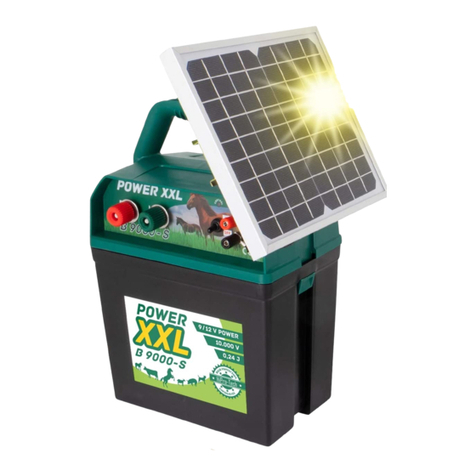fewer materials are required, alterations are easily made, it is suitable for a very wide
range of animals and oers a great deal of protection against injury.
OPERATING PRINCIPLE OF THE ELECTRIC FENCE ENERGISER
The electric fence energiser emits an electrical pulse through the fence about once
every second. The pulse gives the animal a short, sharp, yet harmless shock. This is in
no way dangerous for the animal, but is enough that it will remember to avoid the fence
in future.
PRACTICAL TIPS
Check regulations for your local area before building a fence. You may require permis-
sion to do so. Regularly check the energiser to ensure that it is still functioning properly
by looking at the ashing indicator LED. Check the fence system regularly. Remove
any fallen branches, weeds or bushes as these may cause a short circuit and reduce
the eectiveness of the fence. All animals will need time to learn to respect the fence.
Training may take several days and you may need to make some small adjustments to
the fence.
Animals that can jump may be dicult to fence in. You may need to increase the height
of the fence in order to ensure maximum safety. Make sure to use high-quality insula-
tors. Cheap or cracked insulators and plastic tubes are not recommended as these can
cause short circuits.
Use connecting bolts for all steel wire connections to ensure a good circuit is made.
To ensure correct functionality of the electric fence, ground the energiser using
grounding posts made of galvanised metal. Use double-insulated cable inside build-
ings, under driveways and in places where any galvanised wires lying on the ground
may become corroded. Never use household electrical cables as these are designed
to carry 600 volts at most and a loss of current may occur.
ELECTRIC FENCE REQUIREMENTS
Electric fences and associated equipment must be constructed, operated and main-
tained such that there is no danger to people, animals and their surroundings. Electric
fences in which people or animals can get caught must be avoided. An electric fence
may not be supplied by two separate energisers or by independent fence circuits from
the same energiser.
Where there are two separate electric fences, each supplied by a separate energiser,
the distance between the wires of the two fences must be at least 2.5 m. If this gap
between the fences must be closed o, then this must be done using non-conducting
materials or an insulated metal barrier. Barbed wire or sharp-edged wire may not be
electried by an energiser.
Observe the manufacturer’s recommendations for grounding the energiser.
A distance of at least 10 m must be kept between the grounding electrode for the ener-
giser and any other components connected to grounding systems (such as the ground
connections for power supply systems or telecommunications systems). Connecting
cables that run through buildings must be eectively isolated from grounded parts of
the building. This can be achieved using insulated high-voltage cables.
If connection cables and wires that are part of the electric fence must run near to
high-voltage lines, then they may not be installed more than 3 m above the ground.
This height applies to each side of a right-angled projection from the outer conductor
of the high-voltage cable on the area for a distance of
• 2 m for high-voltage lines that operate at a
rated voltage of up to 1000 V;
• 15 m for high-voltage lines that operate at a rated voltage over 1000 V.
Electric fences intended for scaring o birds, for keeping pets or training animals, e.g.
cows (cow trainer), should only be supplied by a low power energiser (which still has a
sucient and secure eect). Where an electric fence is intended to prevent birds from
nesting on buildings, no wire of the electric fence may be grounded if the fence wires
are not connected to metal parts.
If a wire is connected to a metal part (such as gutter) or a metal structure in the build-
ing, then this metal part must be grounded. A warning sign must be attached at all
points where people are able to access the conductors.
Where an electric fence crosses a public footpath, a non-electried gate or stile must
be present. Each of these stiles must be tted with warning signs indicating that the
fence is an electric fence. Each part of an electric fence that runs along public streets
or other public rights of way must have warning signs securely attached to the fence
posts or wires at regular intervals. Connecting wires that run below the ground must
be placed inside protective insulated pipes or insulated high-voltage cables must be
DE UK FR IT NL SE



























